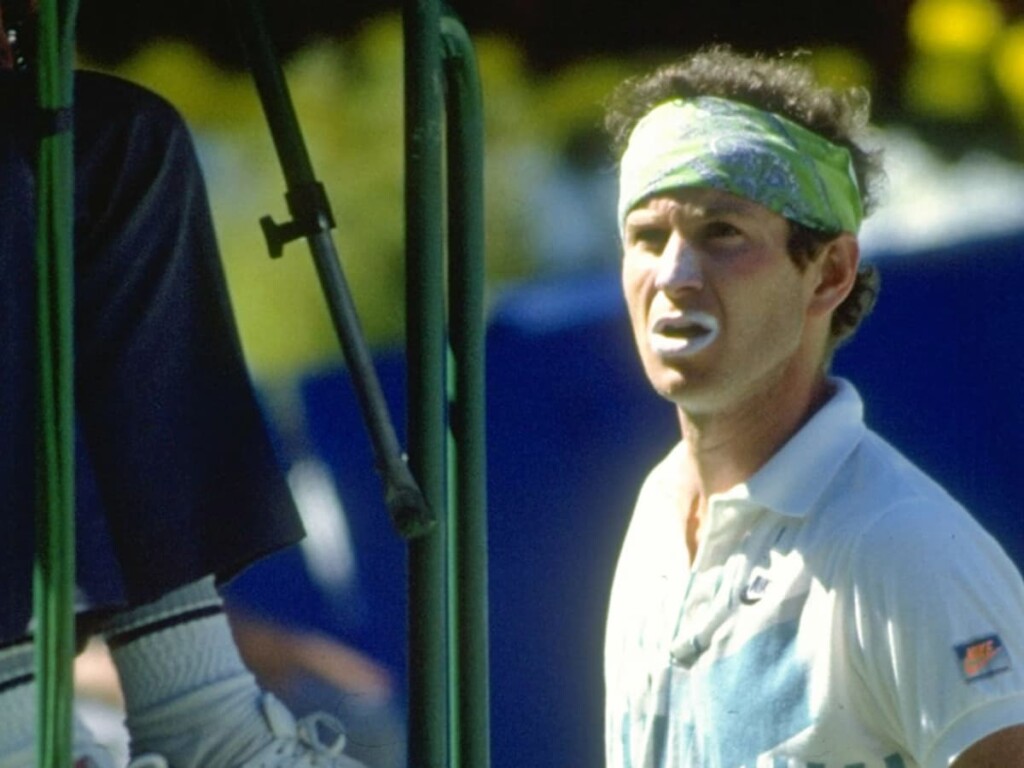‘Tantrum O’Neal’ John McEnroe’s love for creating ruckus remains a major miss as the Novak Djokovic incident in Monte-Carlo raises eyebrows
Foul mouthed Yank John McEnroe is not only famous for his feats on the tennis court but for also his bratty behavior to earn the moniker 'Bad Boy of Tennis'.

John McEnroe and Novak Djokovic
🔍 Explore this post with:
Tennis has heroes but lacks the old characters who turned the court into a theatre where dramas were enacted. These dramas were not one of the dialogues being rehearsed, make-up on, and attracting claps from the audience. For, men like John McEnroe, Goran Ivanisevic, and Jimmy Connors, tennis was a sport plus the natural outbursts.
On a 1 to 10 scale, if someone was notorious on the court, it had to be McEnroe. He had many nicknames, from “Mac-In-A-Row” to “Tantrum O Neal,” a direct link to his Hollywood first wife Tatum O’Neal of Paper Moon movie fame. These days when you watch Mac, his grey hair and so articulate on air, especially at Wimbledon, you will be in awe of his knowledge, command, and how he calls out matches.
Yet, one needs to revisit old Johnny Mac videos and sift through British tabloid headlines which portrayed him as a villain. These days, when the GOAT debate keeps popping up on social media, there are three protagonists, Roger Federer, Rafael Nadal, and Novak Djokovic. Before people jump at why Federer is first on the list, Grand Slam titles won alone do not define greatness. Greatness cannot be measured on a weighing scale or a digital instrument.
After all, daily human life has been invaded by all kinds of meters and meters! Back to Mac, winner of seven Grand Slam titles, the grey looks today convey an impression of a boy who must have behaved best on the court. No, he was the antithesis of good behavior. He was anything but a gentleman but could incite, provoke, and infuriate all involved in the sport — his rival, chair umpires, and spectators.
John McEnroe became the ‘Super Brat’ in the English Summer of ’81

Sample it, in this era, one is talking of Hawkeye not being used in the Monte-Carlo tournament and Novak Djokovic argues with the chair umpire. He is almost too decent to create a ruckus, too calm, though he sticks it his point of where the ball mark was on clay. Throwback to the times when John McEnroe played, in the 80s, irrespective of the surface, the American who takes pride in being a hardcore New Yorker, would turn the match into a tantrum!
There are any number of instances when McEnroe the fiery player was at war with the entire set of people inside the court and outside it. It was one man versus the world, which made for great entertainment. That’s, unless, you think good behavior is a must in sport. Very soon, the French Open will be upon us, and then The Championships. It was at Wimbledon in 1981, John McEnroe, his curly hair, headband in place, tight shorts, and fitting T-shirt caught the eye.
Those days, the human eye was relied upon by line umpires and chair umpires. No technology. McEnroe’s most famous outburst, “You Cannot Be Serious,” against the chair umpire happened while playing against Tom Gullikson. YouTube videos of it are there to see and relish, even today, for it brought out how tennis had characters who were vocal and wanted to prove their point. “You Cannot Be Serious” became like a style, a statement, which was later adapted as a book by McEnroe himself with a co-author.
What was the incident which made McEnroe so angry in the summer of 1981 at Wimbledon? “You cannot be serious,” he screamed. “That ball was on the line. Chalk flew up, it was clearly in, how can you possibly call that out?” ranted McEnroe. “Everybody knows it’s in, in the whole stadium and you call it out? You guys are the absolute pits of the world, you know that?” thundered McEnroe at chair umpire Edward James.
Those days, making calls at Wimbledon was hard. There were chalk markings. Umpires had no replays to rely on. Finally, when Edward James made his decision on a Mac serve, he was extremely polite. “I’m going to award a point against you, Mr. McEnroe,” he announced on the mic. If you ask the New Yorker, also nicknamed as Super Brat how he feels about these incidents being recalled, he will smile.
Bad boy John McEnroe showed the middle finger to Wimbledon, indirectly

On air, McEnroe is witty and sharp. Perhaps, it’s a reflection of his intellect, intelligence, and how he was also impromptu. But how does one explain his temper? He would pout, blow his fuse, and smash the wooden racket. It was part of his game, a maverick and a maestro, who romanced tennis like none before. And then, there was one more incident, where again the chair umpire James had to step in.
“You are misusing your racquet, Mr. McEnroe,” said James, after the wild boy had smashed his racket into grass, leaving it shapeless. “You are an incompetent fool, an offence against the world,” boomed McEnroe, who was docked another point. Today, such talk is impossible on the court. The microphones pick up far too much, almost every word muttered under breath. And it is the same microphone in the TV studio which McEnroe uses to articulate himself at Wimbledon.
For the record, it was in 1981, McEnroe beat Ice Cool Swede Bjorn Borg for his Grand Slam title . The All England Club had to show its power, nay dirty side when that year they refused to give John McEnroe honorary membership of the All England Club. The riposte was superb, Mac skipped the champions dinner, which was like “F**k Y*u” to the Englishmen at large. Sadly, Miss Chris Evert may have missed McEnroe at the dinner.
Why are we talking of all this now? It’s simply because, the romance of Wimbledon in the 80s was so different. These guys played singles, doubles, joked, and fooled around. They had no airs, really. If there was a bad temper and foul language, that was as natural as McEnroe’s swinging serves and classy volley skills at the net. He used that game as his template, almost right through.
John McEnroe’s infamous default from Australia

And in the summer of Australia, McEnroe again gained notoriety, a year earlier, when he was defaulted from the Australian Open. The whole incident involving McEnroe and Mikael Pernfors saw the American using language which is banned. After all, Mac had again broken his racket. Chair umpire Gerry Armstrong, highly respected even today, dealt with the bad boy very firmly. No fear, no mercy. At one stage, McEnroe threw his racket and it cracked.
Armstrong was ready to reprimand the bad boy, in 1990, at age 31. After arguing the racket was not cracked and he could continue, McEnroe tried playing tricks. He knew the racket was a bust. “All I did was crack it,” McEnroe said. “I have every intention of continuing to play with it. Look, it isn’t broken, it’s just a crack.” Said Armstrong: “Let’s play.” The American could not, and then threw a fit, as more officials came out, notably Ken Farrar, another respected tournament referee.
McEnroe was loud and lewd. He yelled at Farrar and demanded he would do something rather obscene involving his mother. There had to be action against McEnroe, hero, and bad boy. Perhaps, he was not aware, rules had been changed and there would be much more than a penalty. “Verbal abuse, audible obscenity, Mr. McEnroe. Default. Game, set, and match, (Mikael) Pernfors,” said Gerry Armstrong.
Replaying the incident, McEnroe has regret as it has been talked of over and over again. “It was just one little four-letter word. The guy could have let me off,” the American said at that time. Sample this, John McEnroe playing today, and all expletives are being let loose. No way, tennis has become far too decent now.
Players have become meeker, tamer. You can hate a John McEnroe and still love him. He was an enigma, incorrigible and recalcitrant. Luckily on air, he is at his best behavior. Want to make comparisons between this yelling Yank and the Fab Three?
Continue Reading:
- Alexander Zverev eulogizes developing RIVALRY between Jannik Sinner and Carlos Alcaraz as new ‘Rafa-Roger rivalry’
- LTA bows down to ATP as they PLEAD for a reduction in their million-dollar fine for banning Russian players

